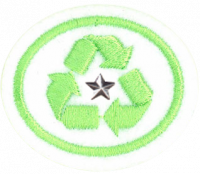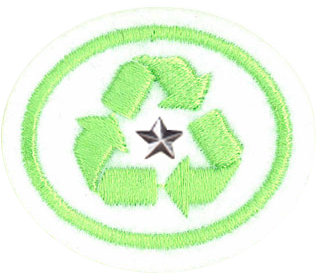Difference between revisions of "AY Honors/Recycling - Advanced/Requirements"
Jomegat bot (talk | contribs) m (Add RequirementsHeader) |
m (- Category of Honor Requirements) |
||
| (11 intermediate revisions by 2 users not shown) | |||
| Line 1: | Line 1: | ||
| − | + | {{HonorSubpage}} | |
| + | |||
| + | <section begin=Body /> | ||
| + | |||
| + | <b>1. <section begin=req1 /><noinclude><translate><!--T:1--> | ||
| + | </noinclude>Have the Recycling honor. | ||
| + | <noinclude></translate></noinclude><section end=req1 /></b> | ||
| + | |||
| + | <b>2. <section begin=req2 /><noinclude><translate><!--T:2--> </noinclude>How does the selective collection of solid waste work in the following locations:<noinclude></translate></noinclude><section end=req2 /></b> | ||
| + | |||
| + | :<b>a. <section begin=req2a /><noinclude><translate><!--T:3--> | ||
| + | </noinclude>Homes | ||
| + | <noinclude></translate></noinclude><section end=req2a /></b> | ||
| + | |||
| + | :<b>b. <section begin=req2b /><noinclude><translate><!--T:4--> | ||
| + | </noinclude>Businesses | ||
| + | <noinclude></translate></noinclude><section end=req2b /></b> | ||
| + | |||
| + | <b>3. <section begin=req3 /><noinclude><translate><!--T:5--> | ||
| + | </noinclude>How does recycling, according to the social context, become a source of income for many families? | ||
| + | <noinclude></translate></noinclude><section end=req3 /></b> | ||
| + | |||
| + | <section begin=challenge /> | ||
| + | <b>4. <section begin=req4 /><noinclude><translate><!--T:6--> | ||
| + | </noinclude>Visit a factory of solid waste treatment and find out what methods are used to recycle materials. | ||
| + | <noinclude></translate></noinclude><section end=req4 /></b> | ||
| + | <section end=challenge /> | ||
| + | |||
| + | <b>5. <section begin=req5 /><noinclude><translate><!--T:7--> | ||
| + | </noinclude>Discover what is the alternative structure of a landfill. Name the main advantages and disadvantages. | ||
| + | <noinclude></translate></noinclude><section end=req5 /></b> | ||
| + | |||
| + | <b>6. <section begin=req6 /><noinclude><translate><!--T:8--> | ||
| + | </noinclude>Make at least two toys out of recycled materials. These toys should be given to children in need. | ||
| + | <noinclude></translate></noinclude><section end=req6 /></b> | ||
| + | |||
| + | <b>7. <section begin=req7 /><noinclude><translate><!--T:9--> | ||
| + | </noinclude>Restore an object that could be thrown away and turned into something useful for your home. | ||
| + | <noinclude></translate></noinclude><section end=req7 /></b> | ||
| + | |||
| + | <b>8. <section begin=req8 /><noinclude><translate><!--T:10--> | ||
| + | </noinclude>Develop a technique for recycling wood, rope or bamboo, after being used for camping. | ||
| + | <noinclude></translate></noinclude><section end=req8 /></b> | ||
| + | |||
| + | <b>9. <section begin=req9 /><noinclude><translate><!--T:11--> | ||
| + | </noinclude>Produce a video or storyboard showing five or more tips on improving the planet by recycling. | ||
| + | <noinclude></translate></noinclude><section end=req9 /></b> | ||
| + | |||
| + | <b>10. <section begin=req10 /><noinclude><translate><!--T:12--> | ||
| + | </noinclude>In places where there is a system of recycling containers, different colors are used. Mention what type of material is used for each color: | ||
| + | <noinclude></translate></noinclude><section end=req10 /></b> | ||
| + | |||
| + | :<b>a. <section begin=req10a /><noinclude><translate><!--T:13--> | ||
| + | </noinclude>Blue | ||
| + | <noinclude></translate></noinclude><section end=req10a /></b> | ||
| + | |||
| + | :<b>b. <section begin=req10b /><noinclude><translate><!--T:14--> | ||
| + | </noinclude>Red | ||
| + | <noinclude></translate></noinclude><section end=req10b /></b> | ||
| + | |||
| + | :<b>c. <section begin=req10c /><noinclude><translate><!--T:15--> | ||
| + | </noinclude>Yellow | ||
| + | <noinclude></translate></noinclude><section end=req10c /></b> | ||
| + | |||
| + | :<b>d. <section begin=req10d /><noinclude><translate><!--T:16--> | ||
| + | </noinclude>Brown | ||
| + | <noinclude></translate></noinclude><section end=req10d /></b> | ||
| + | |||
| + | :<b>e. <section begin=req10e /><noinclude><translate><!--T:17--> | ||
| + | </noinclude>Green | ||
| + | <noinclude></translate></noinclude><section end=req10e /></b> | ||
| + | |||
| + | <b>11. <section begin=req11 /><noinclude><translate><!--T:18--> | ||
| + | </noinclude>How should batteries, light bulbs, or fluorescent tubes be thrown out? Where is the nearest recycling station from your home? | ||
| + | <noinclude></translate></noinclude><section end=req11 /></b> | ||
| + | <section end=Body /> | ||
Latest revision as of 21:15, 21 July 2022
Skill Level
2
Year
2012
Version
20.12.2025
Approval authority
South American Division
1. Have the Recycling honor.
2. How does the selective collection of solid waste work in the following locations:
- a. Homes
- b. Businesses
3. How does recycling, according to the social context, become a source of income for many families?
4. Visit a factory of solid waste treatment and find out what methods are used to recycle materials.
5. Discover what is the alternative structure of a landfill. Name the main advantages and disadvantages.
6. Make at least two toys out of recycled materials. These toys should be given to children in need.
7. Restore an object that could be thrown away and turned into something useful for your home.
8. Develop a technique for recycling wood, rope or bamboo, after being used for camping.
9. Produce a video or storyboard showing five or more tips on improving the planet by recycling.
10. In places where there is a system of recycling containers, different colors are used. Mention what type of material is used for each color:
- a. Blue
- b. Red
- c. Yellow
- d. Brown
- e. Green
11. How should batteries, light bulbs, or fluorescent tubes be thrown out? Where is the nearest recycling station from your home?


